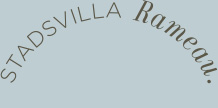THE HISTORY OF VILLA RAMEAU
A VERY OLD STORY
Sexton's house & W.K.L. Rameau
Villa Rameau is located in the former sexton's house of the Pieterskerk Leiden. The sexton couple Rameau lived here from 1916 to 1946. Their sons, Jan and Chris, grew up in and around the Pieterskerk Leiden.
The sexton W.K.L. Rameau (1876-1965) played a special role in the resistance during WWII. On the first day of the capitulation he hid the Great Seal and beadle baton of the Leiden University. 'The Pieterskerk offered unique shelters and for the uninitiated practically inaccessible.', Rameau wrote after the war. Every corner and every empty place suitable, was used as a shelter. The sexton's house served as a base for the resistance. Meetings were held, courier services arranged and identity papers faked.
During WWII, the 3 October thanksgiving for the Relief of Leiden (1574) in the Pieterskerk became a symbol of resistance. The Dutch anthem het Wilhelmus, hymn 301 from the songbook, was invariably used by successive ministers. On the 4th of October 1944 a visitor to the thanksgiving service wrote: 'Yesterday, 3 October, the usual church memorial service in the Pieterskerk, was crowded by 3,000 people, whilst there are 'only' 2,000 places.'
After the liberation Rameau returns the University's property: 'It was a great relief when after the war and just before the reopening of the University in the Pieterskerk, which ceremony also included the interest of our Royal house, that with a sense of satisfaction I handed back, the inviolate property, to the secretary of trustees.'
Prebendary's houses
Between 1594 and 1648 houses were built on all sides around the Pieterskerk Leiden houses. The houses, in different sizes and shapes, were inhabited by elderly - prebendary's - who for a one-off fee bought a lifetime of 'free' room and boarding. The sexton's house is such a former prebendary house.



